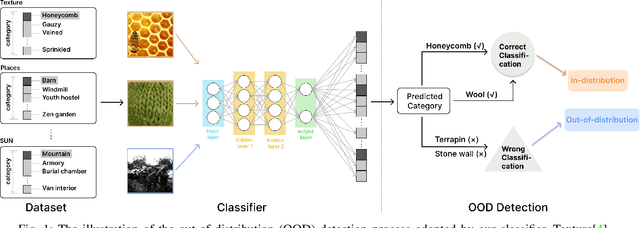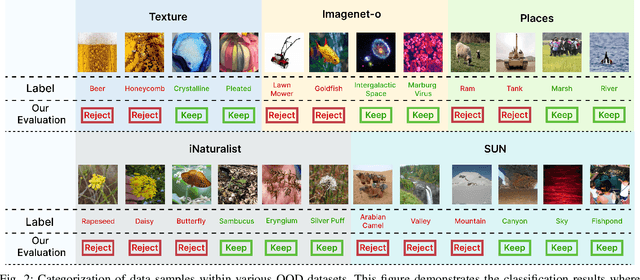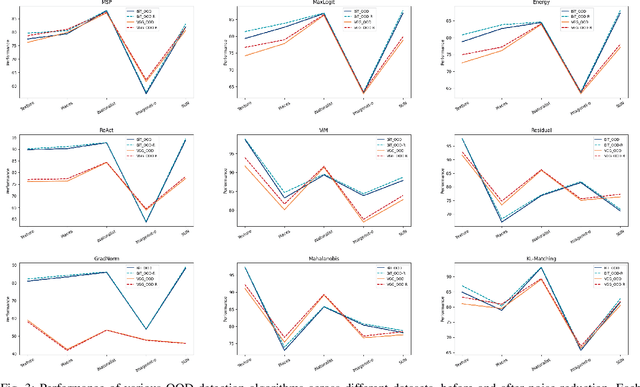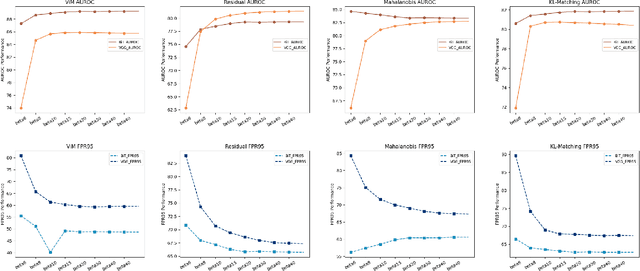Yunlong Kong
Advancing Out-of-Distribution Detection through Data Purification and Dynamic Activation Function Design
Mar 06, 2024



Abstract:In the dynamic realms of machine learning and deep learning, the robustness and reliability of models are paramount, especially in critical real-world applications. A fundamental challenge in this sphere is managing Out-of-Distribution (OOD) samples, significantly increasing the risks of model misclassification and uncertainty. Our work addresses this challenge by enhancing the detection and management of OOD samples in neural networks. We introduce OOD-R (Out-of-Distribution-Rectified), a meticulously curated collection of open-source datasets with enhanced noise reduction properties. In-Distribution (ID) noise in existing OOD datasets can lead to inaccurate evaluation of detection algorithms. Recognizing this, OOD-R incorporates noise filtering technologies to refine the datasets, ensuring a more accurate and reliable evaluation of OOD detection algorithms. This approach not only improves the overall quality of data but also aids in better distinguishing between OOD and ID samples, resulting in up to a 2.5\% improvement in model accuracy and a minimum 3.2\% reduction in false positives. Furthermore, we present ActFun, an innovative method that fine-tunes the model's response to diverse inputs, thereby improving the stability of feature extraction and minimizing specificity issues. ActFun addresses the common problem of model overconfidence in OOD detection by strategically reducing the influence of hidden units, which enhances the model's capability to estimate OOD uncertainty more accurately. Implementing ActFun in the OOD-R dataset has led to significant performance enhancements, including an 18.42\% increase in AUROC of the GradNorm method and a 16.93\% decrease in FPR95 of the Energy method. Overall, our research not only advances the methodologies in OOD detection but also emphasizes the importance of dataset integrity for accurate algorithm evaluation.
Rebuild City Buildings from Off-Nadir Aerial Images with Offset-Building Model
Nov 03, 2023



Abstract:Accurate measurement of the offset from roof-to-footprint in very-high-resolution remote sensing imagery is crucial for urban information extraction tasks. With the help of deep learning, existing methods typically rely on two-stage CNN models to extract regions of interest on building feature maps. At the first stage, a Region Proposal Network (RPN) is applied to extract thousands of ROIs (Region of Interests) which will post-imported into a Region-based Convolutional Neural Networks (RCNN) to extract wanted information. However, because of inflexible RPN, these methods often lack effective user interaction, encounter difficulties in instance correspondence, and struggle to keep up with the advancements in general artificial intelligence. This paper introduces an interactive Transformer model combined with a prompt encoder to precisely extract building segmentation as well as the offset vectors from roofs to footprints. In our model, a powerful module, namely ROAM, was tailored for common problems in predicting roof-to-footprint offsets. We tested our model's feasibility on the publicly available BONAI dataset, achieving a significant reduction in Prompt-Instance-Level offset errors ranging from 14.6% to 16.3%. Additionally, we developed a Distance-NMS algorithm tailored for large-scale building offsets, significantly enhancing the accuracy of predicted building offset angles and lengths in a straightforward and efficient manner. To further validate the model's robustness, we created a new test set using 0.5m remote sensing imagery from Huizhou, China, for inference testing. Our code, training methods, and the updated dataset will be accessable at https://github.com/likaiucas.
 Add to Chrome
Add to Chrome Add to Firefox
Add to Firefox Add to Edge
Add to Edge